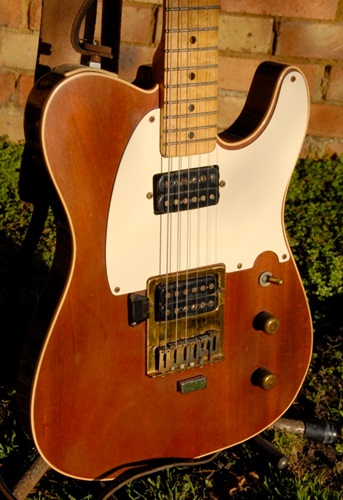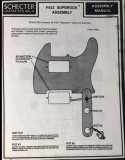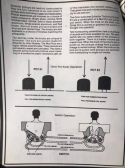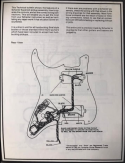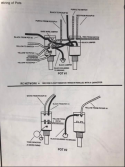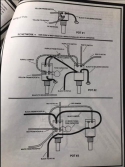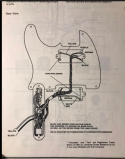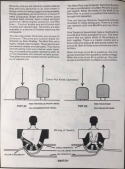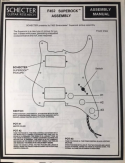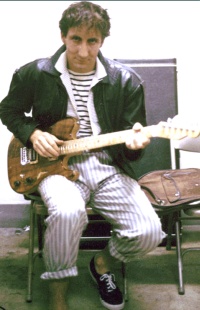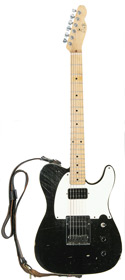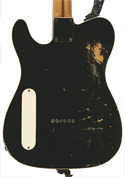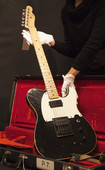Pete’s Gear: Schecter/Giffin ‘Telecaster’-style Guitars
Sale news (1 Aug. 2015): A reported Townshend Schecter is listed for sale on Gbase.
Whotabs has not verified provenance on this item, and is merely posting what is listed in Gbase. Thanks to Marc F. for the tip.
Source: Gbase posting
1980 Schecter Ex Pete Townshend Custom Tele® *The Who*
Schecter Telecaster Custom
Ex Pete Townshend1980 (Circa)
Trans Brown /Cherry
Bound Body
White Pickguard
Gold Hardware
Maple Neck
2+ Humbuckers
“B” Bender Option (String bender)
LP Pickup Selector
CaseHistory /Provenance – The instrument comes with full detailed written and photographic verification
Notes /Comments
The above instrument is synonimous to the Sound /Tone this legandary artist and is the “ROCK” in “ROCK N ROLL”
See Gbase
Additional listing (1 March 2017), h/t to Curt:
Reverb.com lists this guitar as available from Hanks Guitar Shop of Denmark Street, London, originally priced at $38,033.50, but marked down to $32,962.20.
See Reverb.com.
Pete Townshend’s Schecter and Giffin Guitars
Telecaster-style guitars custom-built by Schecter Guitar Research and Roger Giffin, used from September 1979 through 1982 (as well as Live Aid, 1985, and the BPI television appearance in 1988).
Basic specs (see sidebar for specific model differences):
- Dual coil-tapped humbuckers (some Kent Armstrong, some Schecter) with exposed pole pieces on pickup covers.
- The Z+ humbuckers Pete used reportedly were 5,000 turns of .06mm wire DC 3.8-4k ohms ceramic magnets.
- Gibson-type pickup selector toggle switch.
- Chrome Schecter (Kluson) tuners and (later) chrome or black Sperzel locking tuners; one standard string tree.
- Mahogany (Schecter), then Poplar (Giffin) Tele-style bodies.
- 25½″ scale bolt-on rock maple necks; “Telecaster”-style headstock.
- 21 extra-jumbo frets.
- One volume, one tone control, with push-pull coil-tap control.
- Alan Rogan’s straplock system.

Pete began using Tele-style guitars in September 1979, first mixing them in with the Les Paul Deluxes, which were gradually faded out of use by the end of 1979. These guitars were first Schecter-built, then custom-built by Roger Giffin, then finally, custom-built by Schecter. He used the these guitars on stage until 1982 (plus the Gold model on stage for Live Aid in 1985, and with a 1988 television appearance, using a double-bound black model), switching to Eric Clapton model Fender Stratocasters in 1989.
History
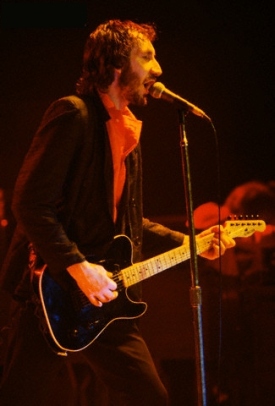
Ca. September 1979, photo of possible first use of Schecter, Madison Square Garden, New York.
Timeline
- First known stage use:
- September 1979, Madison Square Garden, New York
- Last known stage use:
- 8 February, 1988, Royal Albert Hall, London – BPI Awards
Pete’s first Schecter was acquired by Alan Rogan, Pete’s guitar tech, during the September 1979 series of shows at Madison Square Garden, New York. Alan picked up a custom-built guitar made from “Schecter Guitar Research” parts at Manny’s and introduced it to Pete during those shows. It remains unclear whether this was built by Schecter, or another manufacturer in the U.S.
Until mid-1979, Schecter Guitar Research was strictly an after-market parts/kit manufacturer. According to an interview with Schecter president Michael Ciravolo in the September 2006 Guitar World, “well-known repair shops around the U.S., like Rockin’ Robin in Houston and Rudy’s Music in New York, started making their own guitars from Schecter parts. And in mid-1979, Schecter announced the availability of completely assembled Fender-style Schecter guitars, which were sold by 20 retailers across the United States, including Valley Arts Guitars in Studio City, and Manny’s Music in Manhattan.”
Either way, Pete began using these guitars in September 1979, with the first photographic appearance using a single-bound black model.
Upon returning to London, Alan Rogan contacted guitar builder Roger Giffin, about building additional, “lighter” guitars.
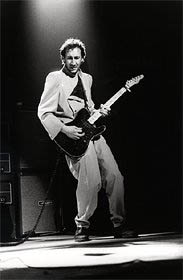
Roger Giffin
Roger Giffin, a guitar builder then based in the UK (who built guitars for Joe Walsh, Eric Clapton and others), made six of these guitars for Pete, as copies of the original Schecter, but with varying details, and some using Poplar instead of Mahogany bodies. The Giffin-built guitars comprised at least three in black (double-bound) and one in two-tone sunburst. The Giffin guitars were assembled and “customized” by Giffin using custom parts.
When Giffin took a position with Gibson Guitars in their custom shop, he was unable to continue making guitars for Pete. So Schecter began making these guitars to basically the same specification on a custom-order basis.
Schecter
At first, Schecter was a small custom order shop and their guitars were not widely available to the general public. They began building guitars for Pete as Giffin was no longer available to do so. The later models, such as the Gold model with no pickguard, were built by Schecter. As Schecter’s guitars became more widely known due to their use by others artists (such as Mark Knopfler and Yngwie Malmsteen), Schecter got into production guitar manufacturing (around 1984). Production was very limited and not widely available but you could find shops that did carry them or could get them.
Giffin details
Details about the Giffin guitars, from Melvyn Hiscock, who worked at Giffin, and is author of “Make Your Own Electric Guitar” and “Make Your Own Acoustic Guitar”:
The first Schecter tele was walnut-coloured (not sure of the wood) but some were made in black (single binding) with mahogany bodies, which were quite heavy. Alan Rogan approached Roger Giffin and requested lighter guitars and so Roger made some with Poplar bodies. These were not made from bought-in parts but were completely built by Roger at Arch 7, Kew Bridge. They were double-bound poplar bodies and one-piece maple necks. Kluson tuners were originally fitted but later replaced with Sperzel. Some had the telecaster-style selector switch replaced with a Gibson-style toggle.
The one shown in the photo at the Hard Rock having been glued back together is a Poplar body. I know this as I glued it back together!
Pickups on all the Schecters were originally Schecter Z+. These were a design submitted to Schecter by Dan Armstrong. Unfortunately, Schecter used an epoxy that was not the original spec and it did not stop shrinking and so they often used to crush themselves out of existence. The coils would just stop working. As a result, Schecter had to approach Kent Armstrong, who had originally designed them, and ask him to sort the problems out. Before this happened, Roger replaced the Schecters with identical pickups made by Kent Armstrong and the Giffins were made with Kent Armstrong pickups.
There was one Telecaster that was labelled as a “Chandler Giffin,” which may have had a Schecter body with a Giffin neck. From memory that was the two-tone sunburst one. In late 1979, Chandler Guitars in Kew became the UK agents for Schecter, but I think the Townshend guitar was prior to this.
In addition, Giffin has said that the Poplar wood used for the bodies was too soft and was easily damaged by Pete, especially due to the large screws used for the custom straplocks installed by Alan Rogan.
Schecter’s retail ‘PT’ model
When Schecter made the first “Pete-style” model available to the public (based on the Gold top model design, with no pickguard and offset controls, though with alder(?) black bodies and dot neck inlays), it wasn’t called anything — and it wasn’t endorsed by Pete (see Pete’s Signature Series). Later, around 1986/87, Schecter named the guitar “Saturn.” The Saturn name was towards the front of the headstock and on the bottom. At some later point in time, it was renamed the “PT,” which are still available today, though the design is substantially different from the original Pete-style model.
Selected quotes from Pete Townshend and Alan Rogan
All quotes and references are copyright their original owners and are included for reference only.
Guitar World, November 1983, excerpt of interview with Alan Rogan
- G.W.: How have his guitars changed since you started working with him?
A.R.: He’s changed his stage guitars, which was a big changeover. We used to use Gibson Les Pauls. One day I spotted a Schecter Telecaster-type guitar and I took it down to the shows we were doing in ’79 at Madison Square Garden and he used it immediately, then we had backups and spares made of that.
- G.W.: How many does he use on stage now?
A.R.: Six to eight with different tunings and capos on different places. They’re made by a guy named Roger Giffin and Schecter. They’re basically the same guitars. They’re exactly the same. About half are Giffins, the rest are Schecters. There’s no difference in the sound. It’s easier to work with a guy in London [then] it is with a company in L.A., you see.
- G.W.: They’re not customized?
A.R.: No, aside from the fact that they have humbucking pickups as opposed to single-coil pickups. They do have the facility of pull-push knobs but Pete doesn’t use them, and instead of having the three-way Fender-type switch, they have a Gibson-type toggle switch so you can flick it much easier when you’re playing, up and down as opposed to left and right. That’s about as customized as it gets.
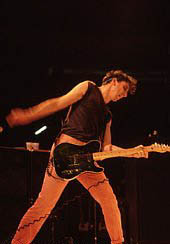
International Musician and Recording World March 1981 ‘Review of the The Who Concert and equipment used at the Granby Halls, Leicester on January 25, 1981,’ by Ken Dibble
The legendary Pete Townshend as wild as ever except that on this occasion no gear was smashed up, played seven or eight guitars which although not exactly identical were very similar indeed. These comprised black Telecaster pattern bodies fitted with Schecter double coil pickups and mainly Schecter fittings, but some has the new Sperzal [sic] machine heads. Some of these guitars were made by Schecter and some by Roger Griffin. All were custom built for Townshend. The reason for so many instruments is so that each guitar can be pre-tuned by Pete’s roadie, Alan Rogan, with capos already in position on various frets to avoid the de-tuning hassle.
From the October 1989 Guitar Player
Despite the apparent randomness, Pete Townshend is actually quite selective and specific about his guitars. “In practical terms,” begins Pete, “I look for strength first, and a solid line from tailpiece to headstock — and that all components in that pathway be of high quality and super strength. I’m also very keen on clean, enhanced treble of the Gibson variety, but with no sustain. This more closely approximates the vibration cycle of the acoustic, and suits my rhythm style far better than charged-up, overwound pickups that whine on for hours. However, when I play solos, I like sustain, so a well-matched guitar and amplifier is the key, one in which the treble doesn’t change — up or down — when you change the level of the guitar into the amplifier. All that should change is the amount of sustain, in my opinion. I got a perfect combination for stage work with my Les Paul Deluxes or Schecter teles run into a master-volume Hiwatt.”
Text from Schecter advertisement, ca. 1983
“My favourite guitar is a rare and expensive ’52 Telecaster. For stage use and recording I need a lighter, tougher and less temperamental guitar. These Schecter guitars are superbly made and easy to play and they sound glorious. They are capable of anything; consistant[sic] but adaptable. Pickups can be changed easily to keep up with the advances made and the bridges, machines etc., can be of whatever standard you want. Don’t be fooled by imitations of old guitars, these Schecters are unique!” (Pete Townshend 1982)
Where are they now?
Pete smashed a few of these guitars. But some have survived. Likely whereabouts of some Giffins/Schecters:
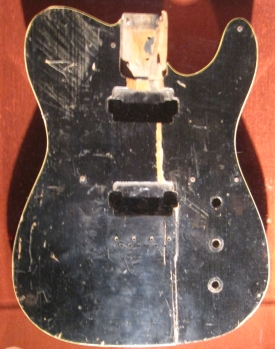
Smashed double-bound poplar Giffin body on display at Hard Rock Café in Chicago.
- A single-bound black Schecter (s/n S8474) is owned by Brad Rodgers.
- The blue (turned green) and double-bound sunburst Giffin were sold by Rock Stars Guitars.
- The gold-top Schecter was retained by Pete, then donated to the Hard Rock Café, and is on display in their New York location.
- Another unknown model is reportedly on display at the Hard Rock Café location in San Diego, California. (If you have further information or photos of this, please contact us.)
- A smashed Schecter/Giffin double-bound black poplar body is on display at the Hard Rock Café location in Chicago. (The plaque incorrectly states that the guitar was smashed at the Chicago Auditorium on 17 August 1971.)
- A smashed Giffin poplar body was retained by Alan Rogan.
-
Unknown model owned by MESA/Boogie
Courtesy Ian at the Boogie Files:
Mike B., head engineer at MESA/Boogie, spent time with Pete and Alan Rogan on the 1982 tour. They used the Boogie 4×12 cabs and some of the Coliseum Series 300 Mark IIB heads. One of PT’s Giffin/Schecter guitars is at Boogie. It was feeding back at the Oakland show and he came to the side of the stage and smashed it as he got another guitar. Alan Rogan looked at it and told Mike it was finished, as the neck was now broken. He gave it to Randy and they fixed it.
Detailed images of Schecter F422 Telecaster Superock pickup assembly guide
An assembly guide from Schecter.
Click to view larger versions.
Click to view larger versions.
Model profiles
Double-bound black Giffin
Black finish, double cream binding, black pickguard and control scratchplate, black hardware (chrome machine heads), straight (Tele-style) control configuration, dot inlay, Giffin neck.
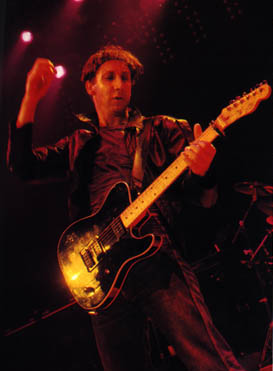
Giffin logo
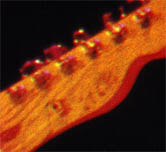
Ca. 1982, double-bound black Giffin Tele-style model. Inset, closeup of Giffin headstock logo. At right, view of straight rear control-cavity coverplate.
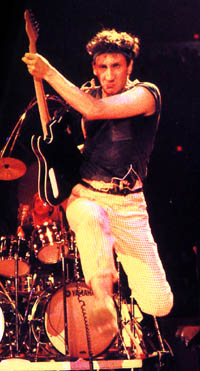
Single-bound black Schecter, no pickguard
Black finish, single cream binding, no pickguard, black hardware, dot inlays, some with Schecter necks, some Giffin; straight (Tele-style) control configuration with Gibson-style toggle switch, no scratchplate under controls.
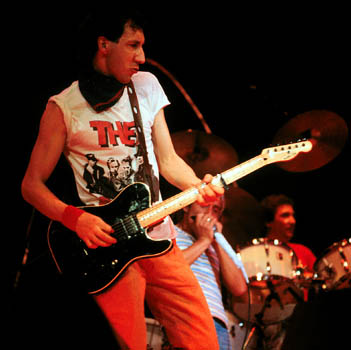
Ca. 1980, with single-bound black Schecter model.
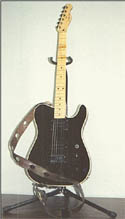
Click to view larger version Single-bound black Schecter (serial no. S8474), with Rose Morris brown leather strap still intact and capo “residue” on third and fifth frets. On display at the Rock and Roll Hall of Fame, Cleveland, Ohio, 1998–2007. Courtesy Brad Rodgers, whocollection.com.
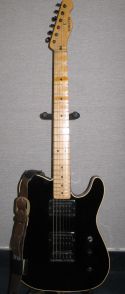
Click to view larger version (215 kb) Single-bound black Schecter (serial no. S8474), with Rose Morris brown leather strap still intact, Alan Rogan straplocks and capo “residue” on third and fifth frets. On display at the Rock and Roll Hall of Fame, Cleveland, Ohio, 1998–2007. Courtesy Brad Rodgers, whocollection.com.
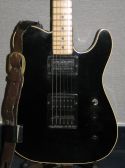
Click to view larger version (273 kb) Single-bound black Schecter (serial no. S8474), with Alan Rogan straplocks, Rose Morris brown leather strap, closeup of body. On display at the Rock and Roll Hall of Fame, Cleveland, Ohio, 1998–2007. Courtesy Brad Rodgers, whocollection.com.
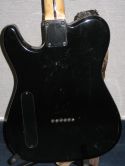
Click to view larger version (203 kb) Single-bound black Schecter (serial no. S8474), rear of body. On display at the Rock and Roll Hall of Fame, Cleveland, Ohio, 1998–2007. Courtesy Brad Rodgers, whocollection.com.
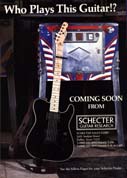
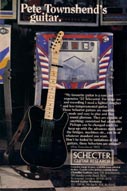
Click to view larger versions Schecter ads, ca. 1983, with likely the same guitar as above (though with black round-button string tree), exhibiting capo “residue.”
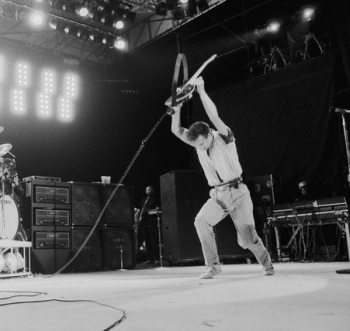
Ca. 1982, with single-bound black Schecter model.
Single-bound black Schecters/Giffins with pickguard
Black finish, single cream binding, black pickguard, black hardware, dot inlays, some with Schecter necks, some Giffin; straight (Tele-style) control configuration with Tele-style toggle switch, black scratchplate under controls.
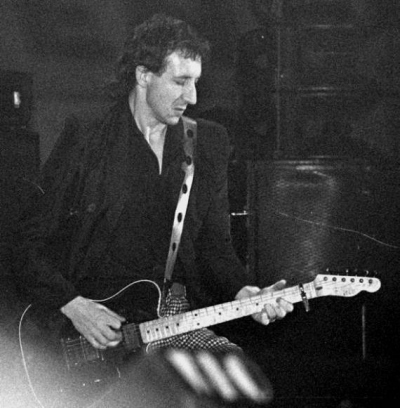
At Zurcher Hallenstadion, 28 April, 1980, with single-bound black Giffin model. Photo courtesy drjazz.ch.
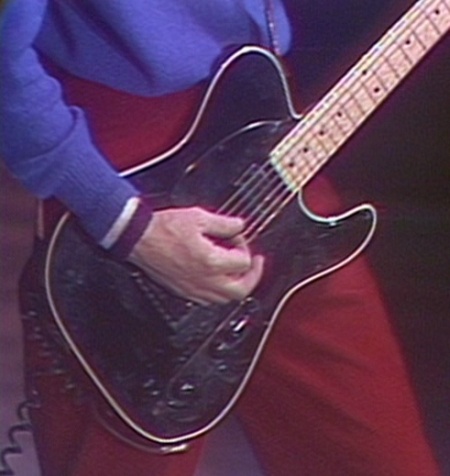
Ca. 1979, detail of single-bound black Schecter model with Tele-style toggle and black pickguard.
Photo series from December 1979, at Buffalo Auditorium and Toronto Maple Leaf Gardens, with single-bound black Schecter model with Tele-style toggle and black pickguard.
Photos courtesy and ©Philip C. Perron. Please respect the owner of these photos and do not reuse them for public or private use.
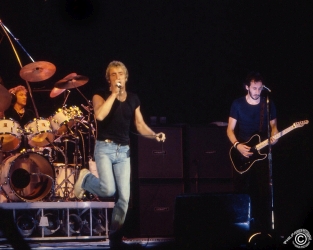
Click to view larger version The Who at Buffalo Auditorium, 1979. Photo courtesy and © Philip C. Perron.
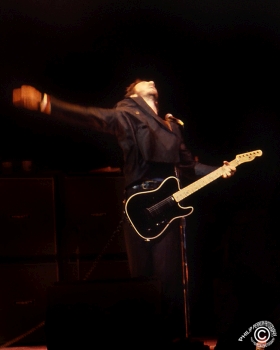
Click to view larger version The Who at Buffalo Auditorium, 1979. Photo courtesy and © Philip C. Perron.
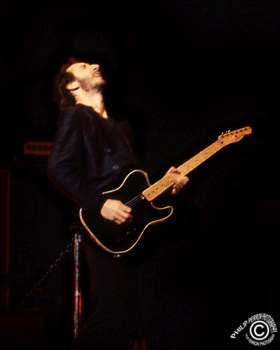
Click to view larger version The Who at Buffalo Auditorium, 1979. Photo courtesy and © Philip C. Perron.
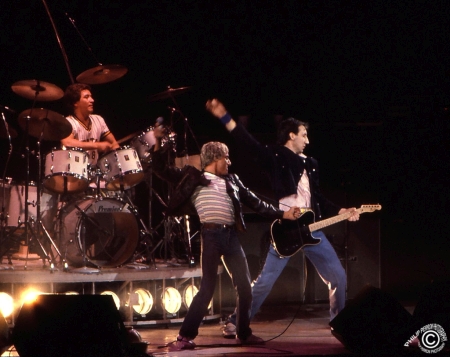
Click to view larger version The Who at Toronto Maple Leaf Gardens, 1980. Photo courtesy and © Philip C. Perron.
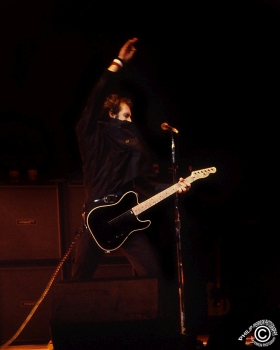
Click to view larger version The Who at Buffalo Auditorium, 1979. Photo courtesy and © Philip C. Perron.
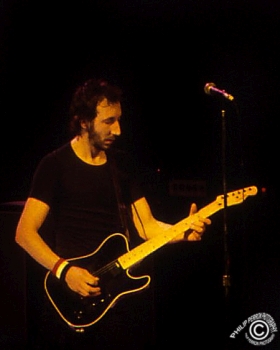
Click to view larger version The Who at Buffalo Auditorium, 1979. Photo courtesy and © Philip C. Perron.
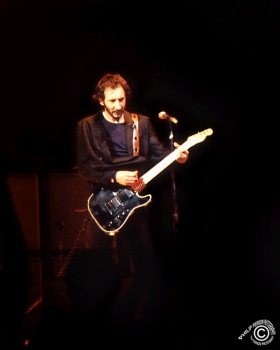
Click to view larger version The Who at Buffalo Auditorium, 1979. Photo courtesy and © Philip C. Perron.
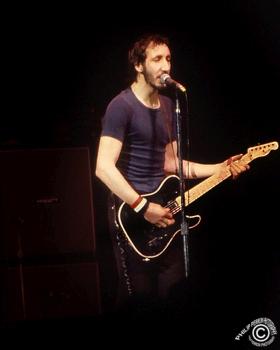
Click to view larger version The Who at Buffalo Auditorium, 1979. Photo courtesy and © Philip C. Perron.
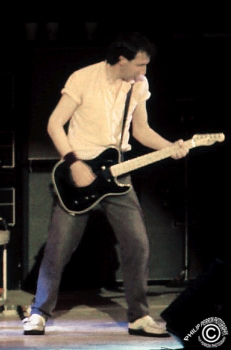
Click to view larger version The Who at Toronto Maple Leaf Gardens, 1980. Photo courtesy and © Philip C. Perron.
Click to view larger versions. Photos courtesy and ©Philip C. Perron. Please respect the owner of these photos and do not reuse them for public or private use.
Double-bound sunburst Giffin
“Sunburst” finish, double cream binding, white pickguard, chrome hardware, straight (Tele-style) control configuration with Gibson-style toggle, no scratchplate under controls, dot inlays, Giffin neck (later replaced).
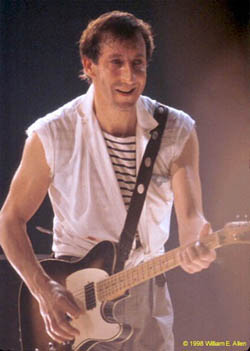
Nov. 30, 1982, with double-bound sunburst Giffin model fitted with solid-logo Giffin decal. Courtesy William E. Allen, techsyscon.com.
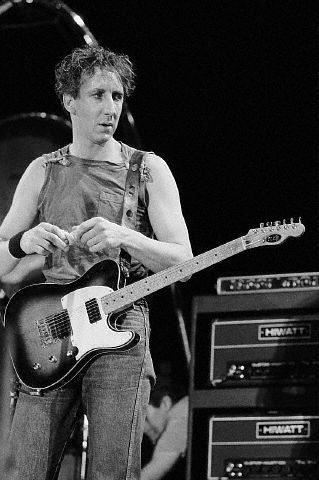
Ca. 1982, with double-bound sunburst Giffin model fitted with solid-logo Giffin decal. Courtesy Mark Herman.
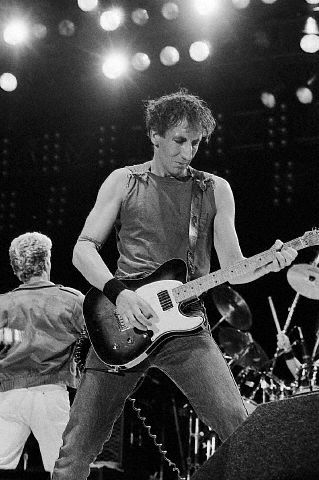
Ca. 1982, with double-bound sunburst Giffin model. Courtesy Mark Herman.
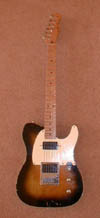
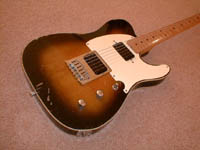
Click to view larger versions Double-bound sunburst Giffin model fitted with Schecter-label neck. Courtesy David Brewis, Rock Stars Guitars.
Unbound blue Giffin-built Schecter
Blue finish, no binding, white pickguard, chrome hardware, straight (Tele-style) control configuration with Gibson-style toggle, chrome scratchplate under controls, dot inlays. Built by Giffin, but has Schecter-label headstock.
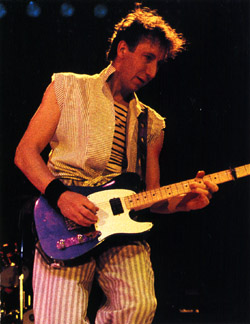
Ca. 1982, with unbound blue Giffin-built Schecter-label model.
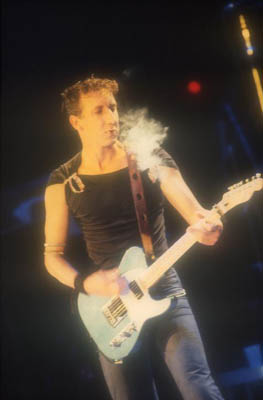
Ca. 1982, with unbound blue Giffin-built Schecter-label model.
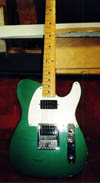
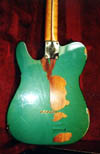
Click to view larger versions Unbound blue Giffin-built Schecter-label model, which turned green after the laminate layer wore off. Courtesy David Brewis, Rock Stars Guitars.
Double-bound black Giffin with white pickguard
Black finish, double-bound cream binding, black pickguard, black hardware, straight (Tele-style) control configuration, dot inlays, Giffin label neck.
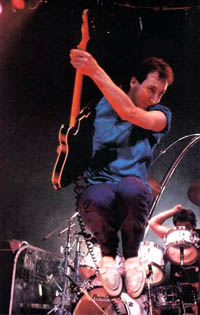
Ca. 1980, with double-bound black Giffin model.
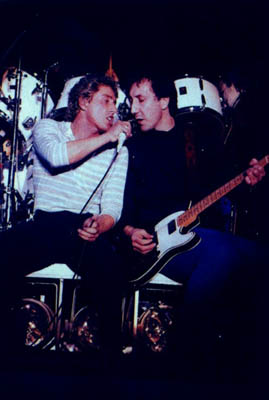
Granby Halls, Leicester, 25 Jan. 1981, with double-bound black Giffin model.
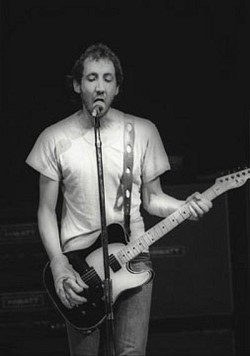
Ca. 1980, double-bound black Giffin model.
Single-bound natural-grain Schecter with white pickguard
Natural (brown) grain finish, white pickguard, gold hardware, straight (Tele-style) control configuration, Gibson-style toggle, no scratchplate under controls, single-bound cream binding.
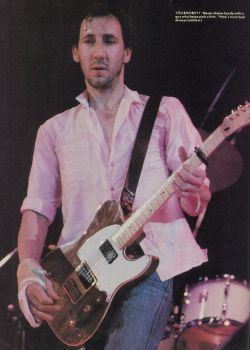
Ca. 1980, with single-bound natural-grain Schecter.
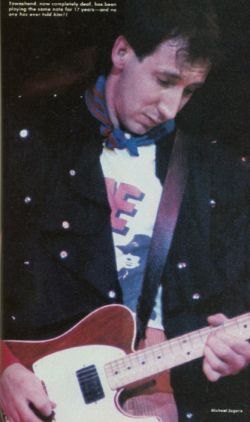
Ca. 1980, with single-bound natural-grain Schecter.
Unbound blonde Schecter with black pickguard
“Butterscotch” (blonde) finish, black pickguard, chrome hardware, straight (Tele-style) control configuration, chrome scratchplate under controls, no binding.
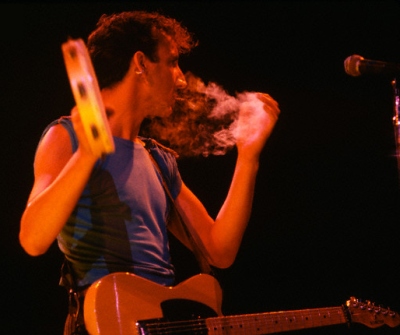
Ca. 1982, with blonde Schecter.
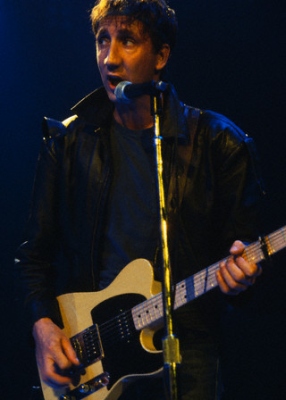
Ca. 1982, with blonde Schecter.
Mahogany Schecter
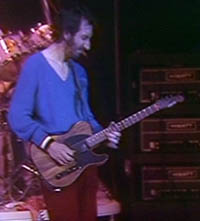
December 1979, with unbound natural walnut-finished Schecter model.
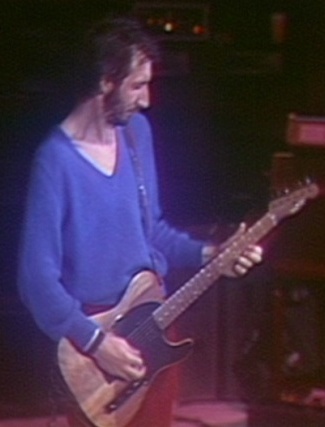
December 1979, with unbound natural walnut-finished Schecter model.
Unbound natural walnut-coloured mahogany body, black pickguard, black or chrome controls, rosewood neck with dot markers, Schecter headstock logo, chrome machine heads. (As seen in Chicago 1979 video clip (Music Must Change) from 30 Years of Maximum R&B video.)
Single-bound gold Schecter
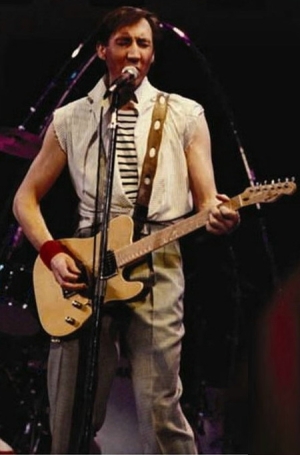
Single-bound (cream) gold finish, natural finish mahogany back and sides, no pickguard, chrome hardware, Fender-style (offset) control array, Gibson-style toggle, Schecter neck, no inlays.
Pete used this model of guitar in 1982, beginning late in the Farewell Tour (as early as 7 December, in Milwaukee, Wisconsin), with its last live use at the 1985 Live Aid show. He retained the guitar, then donated it to the Hard Rock Café, where it is on display in their New York location.
Details
- Pickups:
- Ken Armstrong’s “Z+” coil-tapped humbucker pickups.
- Neck pickup ring:
- ESP, in chrome
- Hardware:
- All chrome, including the bat on the toggle switch. The knobs are the same chrome-dome knobs with knurled sides, the same that Fender USA makes for their Telecaster model guitar.
- Tuners:
- Sperzel, in chrome, with no tightening back screw as found on the contemporary models.
- Jack/jack plate:
- In chrome, presumably Switchcraft; jack plate is also chrome in the oblong “football” shape.
- Body:
- Mahogany and presumably center seamed, natural finish on back and sides.
- Binding:
- Single cream front binding
- Strap locks:
- Alan Rogan’s locking end pins with a huge black turn screw in both positions on both ends of the body. The base of the end pin holder is a huge metal square base that is screwed onto the guitar.
- Tree string guide:
- Brass
- Neck:
- Figured maple neck in a flame-top style, or tiger-striped.
- Frets:
- Jumbo-sized, no fret markers on the face of it, except only at the top of the neck looking down on it from the playing position. Showed very little fret wear.
- Nut:
- Faded yellow, presumably bone, not brass
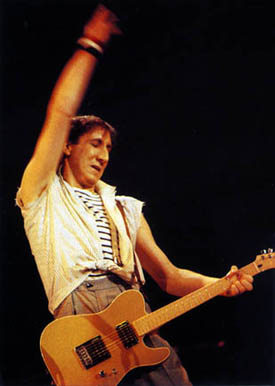
December 1982, with late-era single-bound gold Schecter.
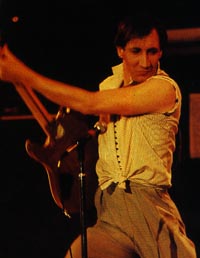
December 1982, rear view, showing oblong rear control cavity coverplate and natural back and sides.
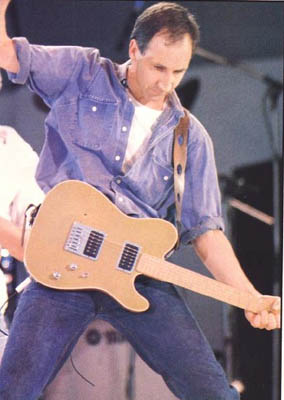
Live Aid concert, 1985, with gold Schecter.
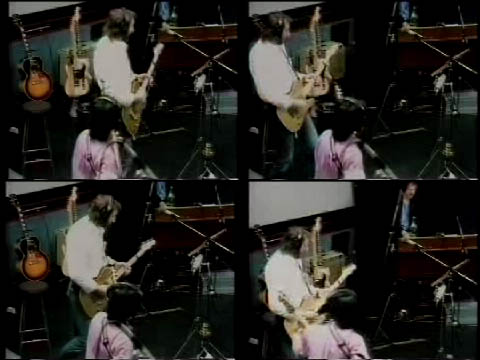
Ca. 1985, recording with the gold Schecter model. The original 1968 Gibson J-200 clearly visible at left, 1952 Fender Telecaster in middle, and Fender Jazzmaster behind Tele. Amp is likely a blonde 1963 Fender Twin.
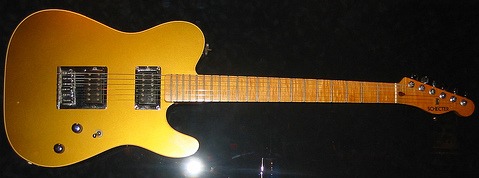
Gold Schecter, on display at the New York location of the Hard Rock Café.
Detailed photos of Gold Schecter at Hard Rock Café, New York
Click to view larger versions. Photos courtesy TommyGuitars.
Click to view larger versions. Photos courtesy TommyGuitars.
Gold Schecter – 2004 display at the Hard Rock Vault in Orlando, Florida
Photos courtesy Michael Mullins.
Click images to view larger versions. Courtesy Michael Mullins.
Non-stage-used models
B-Bender
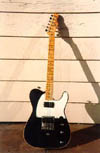
Click to view larger version Courtesy David Brewis, Rock Stars Guitars.
Giffin-built Tele-style model, fitted with Parsons/White B-Bender, as used on Eminence Front and One at a Time. Originally with Giffin headstock logo, later replaced with Schecter logo.
Has bound black body, white pickguard, straight, Tele-style controls, Gibson-style toggle, no scratchplate under controls, Alan Rogan straplocks, chrome hardware, Parsons/White B-Bender, bird’s-eye maple neck with dot markers, Schecter label headstock.
Courtesy David Brewis, Rock Stars Guitars.
Currently on display at Hard Rock Café, Atlantic City, New Jersey.
Quilted sunburst
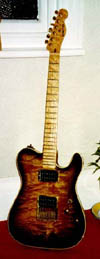
Click to view larger version Courtesy David Brewis, Rock Stars Guitars.
The first of the late-era Schecter models built. With heavily quilted sunburst single-bound (possibly) all-mahogany body, Bird’s-eye maple neck with no fret markers, offset controls, gold hardware and no pickguard. Similar to the gold model used on ’82 tour. Unused on stage: “too nice to beat up.” Courtesy David Brewis, Rock Stars Guitars.
Brown Tele
Backstage, ca. 1982, with what appears to be a Schecter, with straight controls, unbound body, maple neck with dot markers, chrome hardware.
Auction profiles
Schecter auction at Christie’s, 12 June
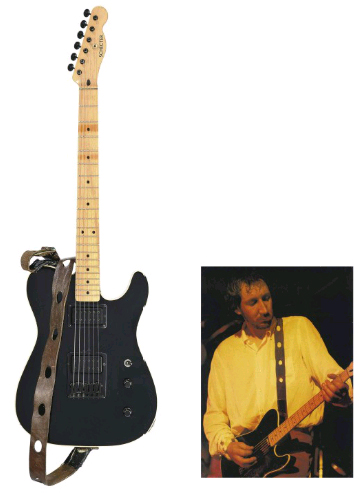
News (June 2012): Christie’s to auction a Schecter guitar, as part of its Popular Culture: Rock & Roll Memorabilia sale, to be held on 12 June 2012, in South Kensington, London. The guitar is currently owned by Brad Rodgers of whocollection.com.
The Who/Pete Townshend
A 1970s Schecter electric guitar, Serial number S8474, in black finish, maple neck with skunk stripe routing, 21 fret maple fingerboard with dot inlays, two rotary controls, one selector switch, with brown leather strap — used by Pete Townshend on stage with The Who 1979–1982, with black rectangular hardshell case; accompanied by a colour poster of Townshend playing the guitar on stage, circa 1979 – 32½×23in. (82.5×58.4cm.)
The Collection Of Brad and Diana Rogers of www.whocollection.com
Exhibited:
The Rock And Roll Hall Of Fame, Cleveland, Ohio 1998–2007
Lot Notes:
Pete Townshend favoured Schecter guitars over his usual Les Pauls towards the end of The Who’s 1979 tour and used this one on stage on various occasions from 1979–1982. The accompanying guitar strap was the strap used by Townshend with this guitar when he last played it in 1982.
Estimate:
£20,000 – £25,000 ($30,880 – $38,600)
Realised:
£22,500 ($34,785)
See christies.com for lot details.
Giffin-label ‘Telecaster’ auctioned 15 Nov., 2011, for £34,850 ($55,865)
News (15 November 2011): Christie’s auctioned a Giffin/Schecter black guitar, as part of its Pop Culture: Rock and Pop Memorabilia sale, on 15 November 2011. The auction realised £34,850 ($55,865).
N.B.: Pete played the Gold Schecter at Live Aid. He did, however, play a black double-bound Tele at the 8 Feb., 1988, BPI Awards show at Royal Albert Hall.
Estimate £30,000 – £50,000 ($47,700 – $79,500)
Realised: £34,850 ($55,865)
Sale 3135, lot 119 Pop Culture: Rock and Pop Memorabilia, 15 November 2011, London, South Kensington
Live Aid Pete Townshend
A Roger Giffin/Schecter guitar, no serial number, Telecaster style body in black finish with white binding, single cutaway body, maple neck with skunk-stripe routing, twenty-one fret fingerboard with dot inlays, two humbucking pickups, selector switch, two rotary controls, bridge baseplate with six adjustable saddles and white pickguard; and a black leather strap and Fender black rectangular hardshell case with red plush lining — Owned by Pete Townshend and used during The Who’s set at Live Aid, Wembley Stadium, 13 July 1985; accompanied by a signed letter from Pete Townshend concerning the provenance in which he states After heavy pressure from Bob Geldof, The Who agreed to reform for a one-off appearance at Live Aid.... Our set was 20 minutes... I used my Black Schecter Telecaster on the last two numbers... It was a great day and I’m glad I was part of it. I think The Who are one of the few acts who appeared at Live Aid and Live 8 twenty years later and a letter from Alan Rogan also confirming its useage (5)
Lot Notes
In one last push to promote the concert Bob Geldof, together with promoter Harvey Goldsmith, went live on BBC Radio 1, to announce to the world that Live Aid would take place on 13 July, just weeks away. Billed as ‘The Global Jukebox’, the event would feature two main concerts, that would run more or less simultaneously in the United States and at Wembley Stadium in London. During the same broadcast, Geldof regaled listeners with a list of artists who would definitely be performing on the day. The list was impressive but what listeners didn’t know was that a large number of the artists hadn’t yet agreed to perform — some of them were yet to be even contacted. Moreover, seconds before the broadcast began, he had been told that his team had just got through to representatives of The Who to discuss their involvement — for Geldof that was enough — he finished his set-list announcement by declaring he’d just been informed that The Who were reforming especially for the concert. On hearing the news both Roger Daltrey and Pete Townshend separately called Bob’s people to find out just what the hell was going on. The reunion of The Who proved to be a major draw for ticket sales, and would eventually be deemed as one of the highlights of the show, by those present.
This is one of Pete Townshend’s Schecter guitars used in early 1980s. Schecter started off as after market parts/kit guitar makers in the late 70s and this guitar was put together by the then Surrey based luthier Roger Giffin, using Schecter parts. The guitar bears Giffin’s name on the headstock. It is understood that Pete Townshend at one stage had a dozen of Schecter guitars for stage use put together by Giffin: a half a dozen or so of them bearing his name on the headstock as well as another half dozen with a Schecter logo on the headstock.
See Sale 3135, lot 119 Pop Culture: Rock and Pop Memorabilia
Resources and Information
Acknowledgements
Tremendous thanks to the following for assistance with this page:
- David Brewis at Rock Stars Guitars, rockstarsguitars.com
- Brad Rodgers at whocollection.com
- Ron Kiska
- Melvyn Hiscock, who worked at Giffin, and is author of “Make Your Own Electric Guitar” and “Make Your Own Acoustic Guitar”
- TommyGuitars
Manufacturer’s sites:
- Schecter Guitar Research: schecterguitars.com.
- Roger Giffin Guitars: giffinguitars.com.
- Kent Armstrong Pickups: kentarmstrong.com.
More information:
- Article on coil-tapping/wiring pickups: “Hot Wiring Your Guitar,” from Electronics & Music Maker – November 1981
